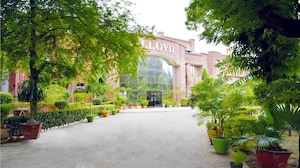In Class 6 NCERT textbook, Madhya Rekha and Sindhu-Sarasvati civilization are mentioned
For the 2024–2025 academic year, students in CBSE Class 6 will now utilize a shortened and updated NCERT social science textbook. Notable revisions include the incorporation of the Sindhu–Sarasvati civilization and the "madhya rekha," India's own Prime Meridian.

The 'Madhya Rekha', India's prime meridian, which passes through Ujjain in Madhya Pradesh and existed considerably earlier than the Greenwich meridian, is discussed in the recently released NCERT Class 6 Social Science textbook.
Additionally, the revised book changes BR Ambedkar's accounts of discrimination eliminates all references to caste-based discrimination, and calls the Harappan civilization "Sindhu-Sarasvati."
It also omits most of the information about ancient Indian kingdoms—Ashoka is mentioned only once in a single word—condenses geography principles, and includes passages from the Upanishads and the Mahabharata.
New NCERT textbooks that align with the most recent National Curriculum Framework for School Education 2023 are being distributed to CBSE pupils in Classes 3 and 6, to use them starting with the upcoming academic year.
The National Syllabus and Teaching Learning Material Committee had previously discussed the possibility of consolidating the three separate books for history, geography, and civics into the new Social Science textbook for Class 6, "Exploring Society - India and Beyond."
MADHYA REKHA: THE FIRST MERIDIAN IN INDIA
The idea of "Madhya rekha," India's prime meridian, which predates the Greenwich Meridian, is one of the notable additions.
"The Greenwich Meridian is not the first prime meridian," the textbook clarifies. Others had existed previously.
In actuality, India had her own prime meridian many centuries before Europe did! It was known as the "middle line," or Madhya rekha, and it went through Ujjayini, or modern-day Ujjain, which was long considered to be a center for astronomy."
Approximately 1,500 years ago, a well-known astronomer named Varāhamihira lived and worked there. Indian astronomers understood the meaning of longitude and latitude, as well as the necessity of a prime or zero meridian.
All Indian astronomical texts now use the Ujjayini meridian as a reference for computations," the textbook states.
THE CIVILISATION OF SINDHU-SARASVATI
With a focus on the Sarasvati River, the textbook renames the Harappan civilization as the Sindhu-Sarasvati or Indus-Sarasvati civilization.
This civilization was known by archaeologists by a number of names, including "Indus," "Harappan," "Indus-Sarasvati," and "Sindhu-Sarasvati." We'll employ each of these words. They refer to their residents as "Harappans." According to the textbook, it is among the world's earliest civilizations.
Unlike in previous editions, the river Sarasvati is referenced repeatedly in the chapter "Beginnings of Indian Civilization," underlining its significance in the history of ancient India. It also points out that the Rig Veda refers to the river.
According to the textbook, the Sarasvati basin contained both smaller towns and cities as well as two of the civilization's largest cities, Rakhigarhi and Ganweriwala."
The river that "today goes by the name of 'Ghaggar' in India and 'Hakra' in Pakistan (hence the name 'Ghaggar-Hakra River')" And is now, the textbook continues, seasonal.
MINIMUM RESEARCH INTO ANCIENT INDIAN KINGDOMS
The portion of the textbook that now covers ancient Indian kingdoms has been drastically reduced.
Four of the chapters from the previous edition have been removed. Stories about the reigns of Ashoka and Chandragupta Maurya, the impact of Chanakya and his Arthashastra, the Gupta, Pallava, and Chalukya empires, and the accomplishments of Kalidasa were all included.
In the updated textbook, King Ashoka is merely mentioned in passing in a timeline in Chapter 4.
Read More
- #NEET
- # NEET UG
- # NEET UG 2024
- # NEET UG 2024
Unlock yourpotential!
Let us know your preference and our team will guide you toward your academic journey. Stay tuned for personalized advice.
FAQ's
The "Madhya rekha" refers to India's prime meridian, which passes through Ujjain in Madhya Pradesh. This meridian predates the Greenwich Meridian and has been used in Indian astronomical texts for centuries.
The Harappan civilization is now referred to as the Sindhu-Sarasvati or Indus-Sarasvati civilization, with an emphasis on the importance of the Sarasvati River in ancient Indian history.
Detailed accounts of Ashoka, Chandragupta Maurya, Chanakya, the Gupta, Pallava, and Chalukya empires, as well as the accomplishments of Kalidasa, have been removed. King Ashoka is now mentioned only once in passing.
The revised textbook removes BR Ambedkar's accounts of discrimination and eliminates all references to caste-based discrimination.
Passages from the Upanishads and the Mahabharata have been added to the textbook, reflecting India's ancient philosophical and religious traditions.
Latest News

The Class 6 NCERT English textbook revised with information that is "Made in India." West out, Bharat in.

UPSC 2024: Static sections, balanced current events, and direct NCERT questions

67 toppers pass NEET UG 2024 as a result of the NCERT book change

Education Ministry Mandates Annual Updates to NCERT Textbooks for Enhanced Learning
Photos and Videos

















COMMENTS (0)